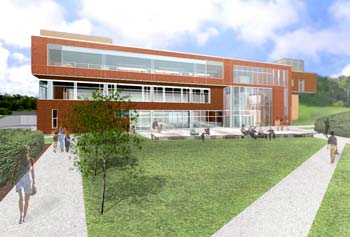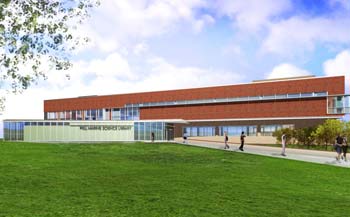NARRAGANSETT, R.I. — November 5, 2007 — The University of Rhode Island broke ground today for construction of a $15 million undersea exploration center and for the expansion and rehabilitation of the Pell Marine Science Library on its Narragansett Bay Campus.
The project is being funded by $14 million in state bonds approved by Rhode Island voters in the 2004 election and over $1 million in private donations.
“This exciting project will integrate key resources and services of the Graduate School of Oceanography to further position it as a 21st century leader at the study of the world’s oceans,” said URI President Robert L. Carothers. “It will provide a focus for new oceanographic activities, including Bob Ballard’s archaeological oceanography program, and link us directly with research ships at sea.”
“This ground breaking marks the beginning of a new era for the University of Rhode Island,” noted Gov. Donald Carcieri. “This is a new chapter in the university’s nationally recognized leadership in oceanographic studies, which is good news for the entire state. This endeavor should spark new economic development in this important area.”
The centerpiece of the 41,000 square-foot facility will be the Inner Space Center, which will use a satellite system and Internet2 to make it possible for URI scientists and students to participate fully in ocean-going research expeditions without leaving campus. Numerous video signals, high-definition imaging systems and two-way audio channels will connect URI�s Bay Campus with its research vessel Endeavor as well as to other research vessels at sea, including the new National Oceanic and Atmospheric Administration ship of exploration, Okeanos Explorer, which is expected to be based at Quonset Point in North Kingstown.
 The Inner Space Center will also be linked with other research institutions around the country, making it possible for researchers to interact in real time with ships at sea, as well as to classrooms in Rhode Island and elsewhere, providing schoolchildren with unprecedented access to science as it happens.
The Inner Space Center will also be linked with other research institutions around the country, making it possible for researchers to interact in real time with ships at sea, as well as to classrooms in Rhode Island and elsewhere, providing schoolchildren with unprecedented access to science as it happens.
“I have dreamed of linking the excitement of undersea exploration with my fellow scientists, students, teachers, and the general public, and now, with the Inner Space Center, this dream can come true,” said marine explorer Robert Ballard, a URI professor of oceanography. “We’re essentially building the ground floor of the Houston Space Center for ocean exploration. It’s incredibly exciting.”
In addition to the Inner Space Center, the new facility will house new office and laboratory space, a central computing facility, administrative offices, and a new campus gathering place. It will allow for growth of the Pell Library’s collection and incorporate new electronic facilities to provide information services to users.
Established in 1968, the Pell Marine Science Library houses one of the nation’s most important collections of oceanographic information, including the National Sea Grant Library, the Narragansett Bay Collection and Bibliography, and the administrative record of the North Cape oil spill. The current facility is above 95 percent capacity and in need of renovation to protect its collections. Expansion of the library will provide additional space for materials as well as an electronic classroom, a map room and a wireless computer network.
“This new facility will become the heart of the Graduate School of Oceanography, a place that will nurture and strengthen interactions between faculty and students,” said GSO Dean David Farmer. “We are creating a building that evokes both a physical and intellectual center for the campus while accommodating the growing information resources necessary to sustain our research and educational programs in the 21st century.”
The architects for the project are Burt, Hill of Boston, while Providence-based Gilbane Building Co. will serve as general contractor. The building is expected to open in the spring of 2009.
URI’s Graduate School of Oceanography is one of the country’s largest and most prestigious centers of marine science education and research. Founded in 1961, it serves a community of scientists who are researching aspects of the biology, physics, chemistry, geology, geophysics and archaeology of the ocean. These include seeking solutions to practical problems such as harmful algal blooms, global warming and climate change, air and water pollution, oil spills, overfishing, and coastal erosion. It is home to the Coastal Institute, the Coastal Resources Center, Rhode Island Sea Grant, the Institute for Archaeological Oceanography, and numerous outreach programs like the Metcalf Institute for Marine and Environmental Reporting.
This groundbreaking event was carried by print and broadcast media including Channels 6, 10 and 12, and WPRO AM radio. Below are links for coverage available online:
- Ground broken at URI sea center Providence Journal, Nov. 6
- WPRO AM

